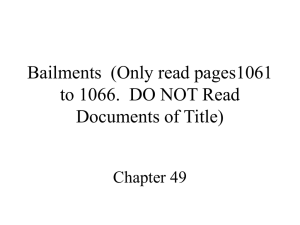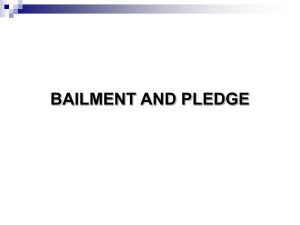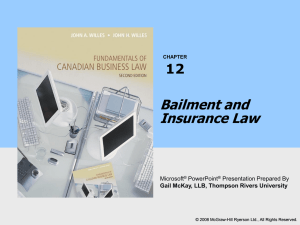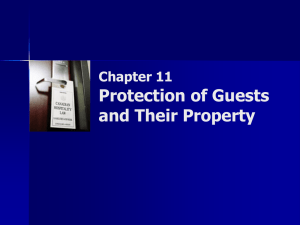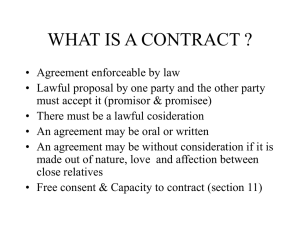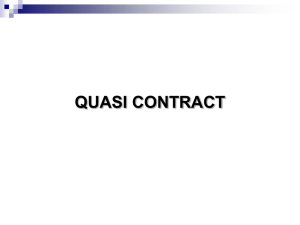Part One: A Continuation of Exercising Rights in
advertisement
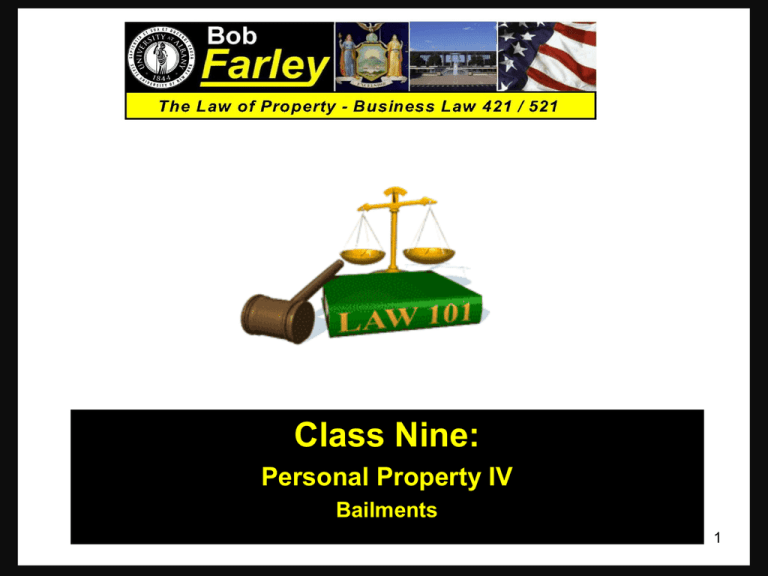
Class Nine: Personal Property IV Bailments 1 Last Time – We Spoke About: • Part One: A Continuation of Exercising Rights in Personal Property – Including: - Liens and Security Interests So here we go. 2 Tonight – We Will Speak About: • Part One: A Continuation of Exercising Rights in Personal Property – Including: - Liens and Security Interests So here we go. 3 BAILMENTS DEFINITION General Definition • A bailment is the relationship created by the transfer of possession of an item of personal property by one called the bailor to another called the bailee for the accomplishment of a certain purpose. • Blacks defines Bailment as: “A delivery of goods or personal property, by one person to another, in trust for the execution of a special object upon or in relation to such goods, beneficial to the bailor or the bailee or both, and upon a contract, express or implied, to perform the trust and carry out such object, and thereupon redeliver the goods to the bailor or otherwise dispose of the same in conformity with the purpose of the trust.” A simple definition of a Bailment is: “A contractual relationship created by the transfer of possession of personal property for a purpose” 4 BAILMENTS Elements of a Bailment DAPPER • • • • • • Delivery Agreement Personal Property Purpose Entered into for the Benefit of one or both parties; and ended with Redelivery 5 BAILMENTS Specific Issues Concerning Bailment Relationship No Transfer of Title The bailment relationship involves the transfer of possession of an item of personal property to the bailee without a transfer of title. Under the terms of the typical bailment, the bailee has the right to possess the property for a period of time and the obligation to return it to the bailor or otherwise dispose of it. Contractual Aspect The bailment relationship may arise from an express contractual arrangement between the parties; however, an express contract is not necessary. 6 BAILMENTS CREATION OF A BAlLMENT 1. Transfer of Possession Since no bailment arises unless the bailee obtains possession of the item of personal property, the first element to the creation of a bailment is the transfer of possession from the bailor to the bailee. For a bailment to exist, there must be actual or constructive delivery by the bailor of the personalty which is accepted by the bailee, actually or constructively. [Weinshenker v. B.T.S., Inc., 210 N.Y.S.2d 271 (1961)] a. Actual Transfer Until and unless the item of personal property comes into the possession of the bailee. the bailee has no rights in that item of personal property. b. Breach If there was a contract between the parties that the would-be bailor breached by failing to turn over the item of personal property to the bailee, a cause of action for money damages only would lie in favor of the prospective bailee. If, however, there was no contract between the parties, then no cause of action would lie. 7 BAILMENTS CREATION OF A BAlLMENT (Continued) 2. Intent to Exercise Control The fact of possession alone is viewed by the New York courts as insufficient evidence of the creation of a bailment. To create a bailment that imposes some element of responsibility on the bailee, New York holds that the bailee must have an intent to exercise control over the item, in addition to possession. Under this view, the often-quoted phrase is: Possession cannot be thrust on a bailee without her consent. The bailee must knowingly take goods into her possession [General Motors Acceptance Corp. V. Grafinger, 61 Misc. 2d 670 (1969)]; thus, liability is not imposed on a bailee in the absence of evidence of delivery and acceptance of the property by the bailee [Swarth v. Barney's Clothes, Inc., 40 Misc. 2d 423 (1963)]. 8 BAILMENTS CREATION OF A BAlLMENT (Continued) 2. Intent to Exercise Control (Continued) a. Custody Distinguished The delivery of an item of personal property without the acceptance or acquiescence of the bailee does not, in the view of the New York courts, create a bailment. Mere custody of the item of personal property results where possession is forced on the possessor. [Posner v. New York Central Railroad, 154 Misc. 591 (1935)] b. Involuntary Bailee Some courts hold that where there is a transfer of possession but there is no acquiescence on the part of the possessor (would-be bailee) to receive possession, a bailment nevertheless results. This would follow from the straightforward interpretation of the bailment definition that the bailment arises from possession of the item of personal property. Following this line of cases, the bailee can be described as an involuntary bailee. While he holds the goods subject to an involuntary bailment, no affirmative duty of care is placed on him which would render him liable to the bailer. [Portable Machinery Co. v. Krakawka, 141 Misc. 123 (1931) - buyer notifying seller of refusal to accept defective property became bailee thereof] c. Generic Intent It may be that one may acquire possession of an article without knowing its precise identity. A bailment will nonetheless result as long as the person receiving possession (i.e. the bailee) has formed a generic intent to receive the article and create a bailment. The most common example is where an article is contained within another item of personal property which is the actual subject matter of the bailment. A voluntary bailment will be created where the bailee receives an article and has constructive 9 knowledge of its contents. BAILMENTS CREATION OF A BAlLMENT (Continued) 2. Intent to Exercise Control (Continued) d. Examples 1) Usual Automobile Contents: An automobile is brought to a parking lot and bailed. The bailee has created a voluntary bailment with regard to not only the automobile but also all contents which are normally found within the automobile. The bailee will be presumed to have constructive knowledge of, and be liable for, such normal contents as a spare tire even though they may have no precise knowledge that the item is contained within the automobile. 2) Special Automobile Contents: Other articles in the trunk of a car stored in a parking lot may not be the subject of a bailment (nor should they be considered the subject of an involuntary bailment) where the bailee does not actually know or have constructive knowledge of the contents. On this basis, if the car were to contain a fur coat, no bailment would result as long as the bailee of the automobile did not actually know of the fur coat. As a result, such bailee would not be charged with constructive knowledge of the fur coat. 3) Hidden Fur Piece: Where a coat in which a fur piece is concealed is deposited in a checkroom and the fur piece is not returned, the owner of the checkroom is not liable for the loss because he was not a bailee for the fur piece. For in this case, the owner of the checkroom did not know the fur piece was concealed in the coat and would have no reason to know that such item would be concealed within a cloth coat. On this basis, one could say that no bailment resulted nor did an involuntary bailment result. 10 BAILMENTS SPECIAL SITUATIONS 1. Parking Lots (Bailment of Space Rental?) Parking a car in a parking lot may constitute a renting of parking space or it may create a bailment. Whether a particular transaction amounts to a bailment or to the mere renting of parking space will depend on whether the owner surrendered control over the car to the operator of the parking garage. Thus, the turning over of the keys by the owner to the operator or the use by the latter of a checking system would indicate a bailment. [Fire Association of Philadelphia v. Fabian, 170 Misc. 665 (1938)] If, however, the car owner does not surrender the keys, the New York position is that the transaction was a mere leasing of space. 2. Safe Deposit Boxes The relationship between the proprietor of a safe deposit vault and one who rents a box is that of bailor and bailee. Usually, the bank and the "renter" of the box have duplicate keys, but the renter cannot have access to the box without the consent and use of the bank's duplicate key. This type of almost absolute control by the bank over the box and its contents renders the bank a bailee. 3. Garagekeeper A garagekeeper is a bailee for hire. 11 BAILMENTS SPECIAL SITUATIONS (Continued) 4. Checkroom Deposit a. Negligence General Business Law Section 201: Limits recovery by a patron who sues for negligence: 1) To the value of the coat if: (i) negligence is shown, (ii) a fee is charged for checking the coat, (iii) a value in excess of $200 is declared, and (iv) a written receipt stating the value is issued when the coat is given to the attendant. 2) To $300 if: (i) a value in excess of $200 is declared, and (ii) the other conditions are met, but negligence cannot be shown. 3) To $200 if: No fee or charge is exacted; or (i) a value in excess of $200 is not declared; and (ii) a written receipt is not obtained when the coat is delivered. b. Posting of Statute General Business Law section 201 protects owners of hotels, motels, or inns, provided that the owner causes copies of the statute to be posted in conspicuous places on the premises. This section can also protects the owner of a restaurant, even though the statute is not clearly posted about the premises. [Weinberg v. D-M Restaurant Corp., 53 N.Y.2d 499 (1981)] c. Conversion The provisions of General Business Law section 201 DO NOT APPLY when the customer sues for theft (conversion) by the owner or owner's employees. 12 BAILMENTS SPECIAL SITUATIONS (Continued) 5. Restauranteurs Coats on Hooks: Restaurateurs are not liable for coats on hooks near a guest's seat. [Wielar v Silver Standard, Inc., 263 A.D. 521 (1942)] 6. Storekeeper Items Necessarily Laid Aside: A storekeeper is a bailee of articles necessarily laid aside and is liable for loss or damage, such as where an old coat is put aside while the customer is trying on a new one, or where money is stolen from pants in a booth while the customer is involved in a new measuring. 9. Bank as Bailee Bailee of Deposits: A bank is a bailee of deposits received during the period after its closing time and the opening of its next business day. 13 BAILMENTS BAILMENTS DISTINGUISHED 1. Bailment vs. Consignment A consignee differs from an ordinary bailee in that he is authorized to sell the goods in the ordinary course of trade. Hence, a consignment may be described as a special bailment for the purpose of sale. In a true consignment for sale, the consignee is not only a bailee but also an agent of the consignor to sell the goods. 2. Bailment vs. Sale A sale involves the transfer of title to the vendee. A bailment, on the other hand, involves merely a transfer of possession to the ballee. The title to the goods remains in the bailor. A fairly workable rule to determine the nature of any given transaction has been presented as follows: When the identical thing delivered, is to be restored in the same or in an altered form, the contract is one of bailment, and the title to the property is not changed. When there is no obligation to restore the specific article, and the receiver is at liberty to return another thing of equal value, or the money value, then the title to the property is passed and it is a sale and NOT a Bailment. 14 BAILMENTS BAILEE'S RIGHTS WITH RESPECT TO THE BAILED GOODS 1. Possession The bailee has the exclusive right to possession of the property during the bailment, provided he is exercising this right according to the terms and conditions of the bailment. 2. Use of Bailed Goods Ordinarily, the bailee has no right to use the subject matter of the bailment. However, he may acquire this right by express or implied agreement with the bailor. a. Implied Use Preserve the Condition of the Item: Older decisions establish that a stable keeper has presumed authority to exercise a horse or to milk a cow to preserve the health of the animal. b Agreed Use The Parties Agree to the Use: In bailments for the hired use of personal property, the bailee obviously has the right to make the agreed use of the property bailed. The same is true of the gratuitous loan of an article for use. In such cases, however, the bailee's use of the bailed article is limited by the terms of the agreement. c. Incidental Use Incident to Bailment Purpose: In bailments for storage, repairs, or transportation, the bailee is under a duty not to make any use of the property except such use as is incidental to the performance of his services. 3. Actions Against the Bailee When, due to the wrongful act of the bailee, the goods bailed have been lost or damaged, the bailor has several options available to him. a. Breach of Contract; b. Action in Tort for Damages; c. Action in Conversion; and 15 d. Replevin for return of the item. BAILMENTS BAILEE'S DUTY WITH RESPECT TO THE BAILED GOODS 4. Bailee's Duty of Care The traditional view is that the standard of care applicable to a bailee depends on the type of bailment involved. A bailee is not an insurer of the safety of the goods bailed, but will be liable only for failure to adhere to the standard of care imposed on them by virtue of the type of bailment. a. Sole Benefit of the Bailor (Gratuitous) Generally, where the bailment is for the sole benefit of the bailor (e.g., where the bailee is uncompensated), the bailee must exercise only slight care with respect to the goods bailed. He is liable only for gross negligence with respect to the bailed goods. Examples: 1) A gratuitous bailee of furniture could be held liable for failure to insure the furniture after making a promise to insure it 2) A gratuitous bailee of storage trunks may be liable for an unexplained failure to return the property. [Dalton v. Hamilton Hotel Operating Co., 242 N.Y. 481 (1926)] Note: A three-year statute of limitations applies to actions in which a bailor seeks a recovery because of loss of or damage to goods held under a gratuitous bailment. 16 BAILMENTS BAILEE'S DUTY WITH RESPECT TO THE BAILED GOODS 4. Bailee's Duty of Care (Continued) b. Sole Benefit of the Bailee (Gratuitous) When the bailment is for the sole benefit of the bailee (e.g., the bailor gratuitously loans his property), great diligence is required. The bailee will be liable for even slight negligence. 1. Limitation No liability is imposed on a bailee for loss caused by an independent agency where the bailee exercised at least ordinary care. [Hobbie v. Ryan, 130 Misc. 221 (1927)] Note: A bailee's promise of freedom from "risk from all hazards“ makes them liable for robbery. [Eckel v. Trencher Furs, Inc., 191 Misc. 14 (1947); Balice v. Erie Railroad, 208 A.D. 427 (1924)] 2. Bailor's Duty A bailor has a duty to warn a gratuitous bailee user of known defects. [Hood v. State, 48 Misc. 2d 43 (1965), aff’d: 28 A.D.2d 1034 (1967)] 17 BAILMENTS BAILEE'S DUTY WITH RESPECT TO THE BAILED GOODS 4. Bailee's Duty of Care c. Mutual Benefit Bailment (Commercial) Bailments for hire and pledges are for the mutual benefit of the bailor and bailee. In such instances, the bailee must exercise a duty of ordinary care. The bailee will be liable for their ordinary negligence. d. Modern Approach to Duties Modern courts tend to reject this three-step standard and simply hold the bailee to a duty of ordinary care in light of the circumstances. New York decisions appear to be moving toward this trend. 18 BAILMENTS BAILEE'S DUTY WITH RESPECT TO THE BAILED GOODS 5. Absolute Liability The bailee is absolutely liable for loss or damage without regard to her degree of care under each of the following circumstances: a. Departure from Terms of Bailment The bailee is rendered absolutely liable as a converter if they depart from the terms of the bailment, (e.g., by using the goods for a different purpose than the one agreed on). In addition, absolute liability attaches if the bailee removes the goods from an agreed place of storage to another without the bailor's knowledge or consent. b. Breach of an Agreement to Insure When the bailee expressly agrees, or by custom or previous course of dealing impliedly agrees, to insure the goods against hazards, but fails to do so, and the goods are damaged or destroyed by such hazard, the bailee is rendered absolutely liable. c. Misdelivery Upon the termination of the bailment, the bailee owes a duty to redeliver or account for the thing bailed in its original or agreed-upon altered form. Delivery must be made to the bailor or someone claiming under him. Almost Always Absolute Liability Although a bailee is held only to a standard of reasonable care with respect to protection and preservation of the bailed chattel, they are absolutely liable for improperly delivering the bailed chattel to someone other than the bailor. Such misdelivery is a breach of the bailment and a conversion of the bailed chattel. Therefore, the liability is absolute and not based on negligence. 19 Exceptions - Adverse Claimants and Contractual Limitation of Liability BAILMENTS REIMBURSEMENT AND COMPENSATION 1. Reimbursement The general rule is that ordinary expenses must be borne by he bailee and extraordinary expenses by the bailor. Consequently, if the bailee pays an extraordinary expense, not incurred through their own fault, they are entitled to reimbursement from the bailor with respect to such expense. For example, in the rental of a car, the cost of gasoline, oil, and such minor repairs as fixing a flat tire, would be ordinary expenses. The cost of a new tire and tube, necessitated by a blowout (there being no spare tire), or the repair of a broken axle would be extraordinary expenses. 2. Compensation In a bailment for the mutual benefit of the bailor and the bailee, the bailee is entitled to receive the agreed compensation for their services or, in the absence of such agreement, the reasonable value of such services. In other types of bailments (ie., gratuitous, sole benefit of bailee or bailor), however, the bailee is entitled to no compensation. 20 BAILMENTS TERMINATION Generally, a bailment may be terminated by agreement or by conduct of the parties. 1. By Agreement The mere lapse of a specified time for the accomplishment of the purpose terminates a bailment. [Rentways, lnc. v. O'Neill Milk & Cream Co., 308 N.Y. 342 (1955)] 2. By Conduct of the Parties Notice to the other party, where the bailment is for an indefinite period, resumption of possession by the bailor, mutual agreement, destruction of the property, or misconduct of the bailee will terminate a bailment. [Pezzo v. Paterno, 277 AD. 496(1950), rev'd on other grounds, 302 N.Y. 884 (1951)] 21 • Bonus Question of the Day • For next time – Read Assignments on the Website for Intellectual Property and Criminal Law • Questions??? • Have a Wonderful Week 22
